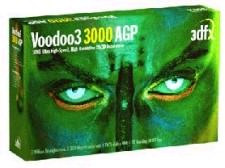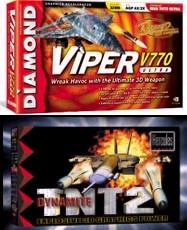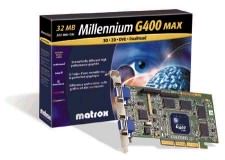| Barrage of Boards: 3d Update
by John Reynolds |
||||
|
I've owned a PC for some seven years now, and never before have I seen such a deluge of new video boards flooding the market, and all within a relatively short timeframe. 3dfx, Nvidia, Matrox and others: too many roads and not enough maps! 3dfx released the first two-thirds of their V3 lineup in early April, nVidia has ignited its TnT2 offering in May, the G400 boards will soon be available, S3 hopes to soon roar back into the hearts of gamers with its Savage4, and Videologic will release their PowerVR Neon 250 later this summer. But which board is right for you? Well, Combatsim seeks to offer a little help by examining the pros and cons, strengths and weaknesses, of each of these new boards.
 Voodoo3-the first out of the gate in this new generation of video chips, 3dfx's latest has been called by some the Banshee2, and not in a complimentary manner. The third offering of a 2d/3d solution by 3dfx, the V3 offers outstanding 2d quality due to its high RAMDAC, 16mg of onboard memory, the closest thing to perfect compatibility with all games currently on the market, possibly the best overall raw peformance, and a surprising improvement in image quality over that of last year's Voodoo2. On the downside (there always has to be one, doesn't there?), the V3 lacks what some consider important features, such as 32-bit output, large texture sizes, and AGP texturing, and while these aren't critical omissions for today's games the 16-bit rendering limitation of the V3 definitely shortens its expected lifespan. For the best V3 review yet written, check out Extreme Hardware's 18-page, exhaustive examination. TnT2- essentially a TnT1 shrunk down on a smaller micron .die to achieve higher clock speeds without melting, this chip comes in two flavors, the TnT2 running at 125mhz and the TnT2 Ultra w/32mg clocked at 150mhz+. The "plus" indicates that companies such as Hercules are actually shipping their boards above this default speed- 175mhz and 200mhz in this case- which could turn such cards into fire-breathing dragons, performance-wise. The TnT2 offers excellent image quality combined with V3-level performance and a rich suite of features guaranteed to satisfy the most demanding of gamers. |
 Moreover, nVidia has excellent D3D drivers and probably the best consumer-level OpenGL ICD currently on the market. On the downside, to achieve V3-performance in multitextured titles usually requires the more expensive TnT2 Ultra, and some of its features, such as 32-bit output, have an undesirable impact on framerates-the Q3test, for example, takes upwards of a 40% performance hit when moving from 16- to 32-bit color depth on a regular TnT2. And in spite of otherwise excellent driver support, nVidia has yet to fall in behind AMD's 3DNow!, though they've promised to remedy this as soon as possible. For a thorough look at the TnT2 chip, turn your browser toward Anandtech. G400-Matrox tried re-entering the 3d arena with last year's G200, a decent 2d/3d board that boasted excellent 2d quality with only moderate 3d speed, a performance that was further hindered in many games by an OpenGL ICD that was nothing more than a D3D wrapper. This year's G400 is, in my opinion, the most surprising entry into the acceleration arena; I honestly didn't expect Matrox to ship a compelling product.
 But they have, and the G400 sports outstanding 2d quality, 16-32mg of onboard memory, an actual working ICD, and unparalleled 32-bit performance. The G400 is also the first chip that supports environmental bump-mapping, a feature that's incorporated in MS' DX6.0 and that allows developers to basically texture their textures. Go to Page Two
|
|||
|
Copyright © 1997 - 2000 COMBATSIM.COM, INC. All Rights Reserved. Last Updated May 25th, 1999 |
||||
